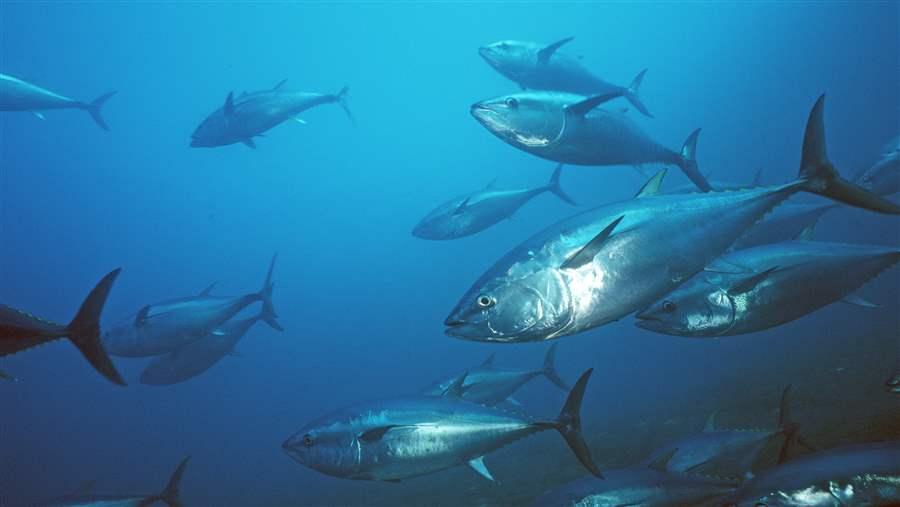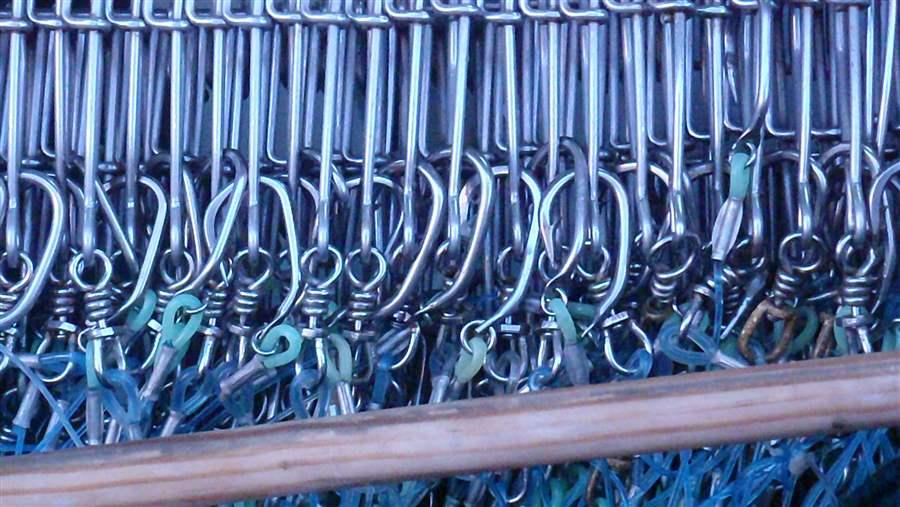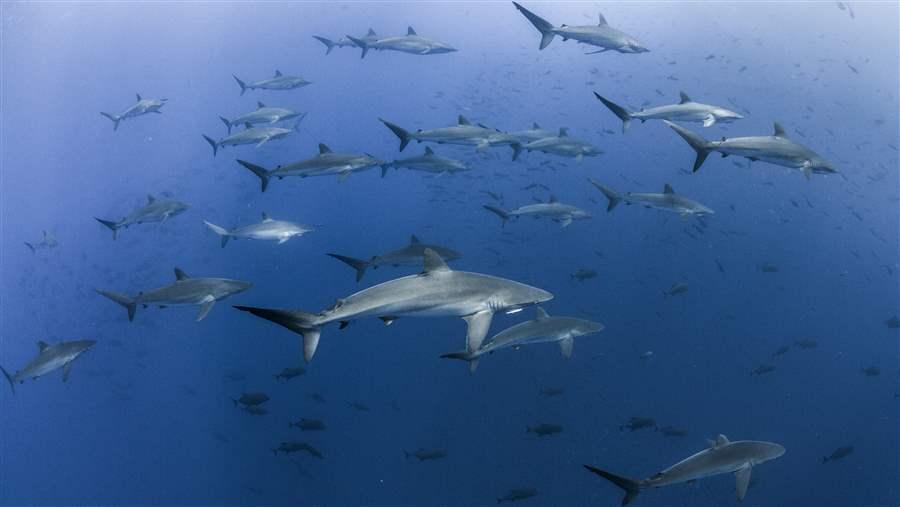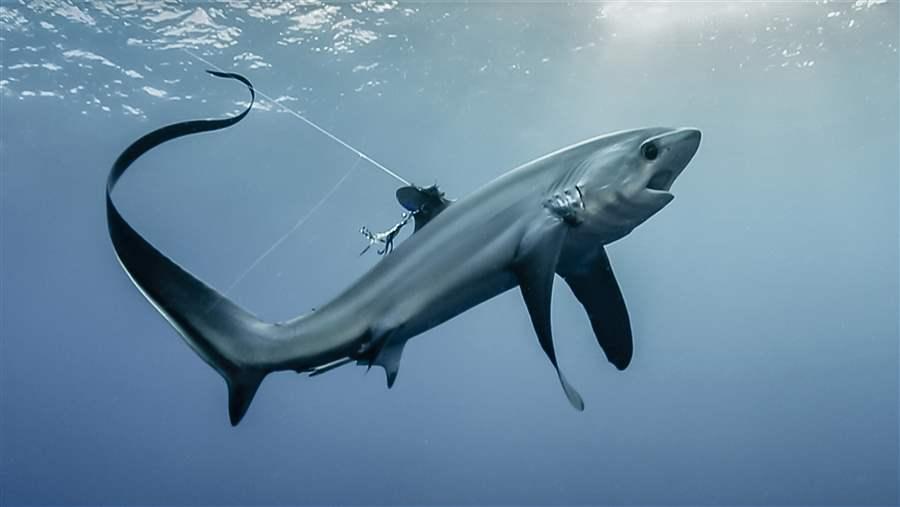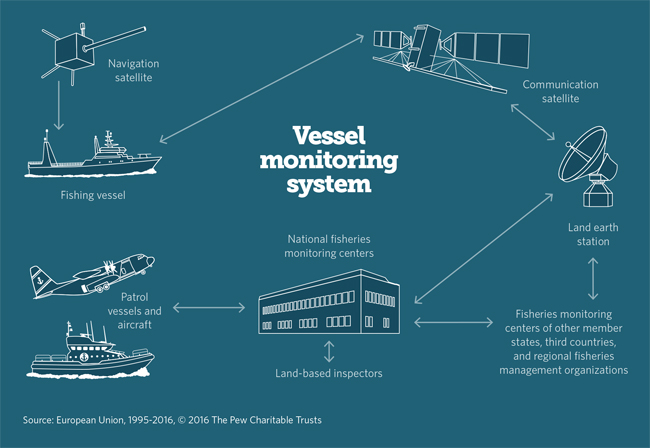Recommendations to the 92nd Meeting of the Inter-American Tropical Tuna Commission
24–28 July 2017, Mexico City
The Inter-American Tropical Tuna Commission (IATTC) is responsible for the conservation and management of tuna, sharks, and other highly migratory species in the eastern Pacific Ocean. It is the obligation of Member States to enforce strict compliance with measures adopted by the Commission.
The Pew Charitable Trusts calls on Members and Cooperating Non-Members at the 92nd Meeting of the IATTC to take these critical actions:
- Implement strong conservation and management measures for tuna species.
- Agree on a rebuilding plan for Pacific bluefin tuna.
- Commit to effective management of fish aggregating devices (FADs) to reduce their impact on vulnerable species.
- Increase observer coverage on longline vessels.
- Adopt conservation and management measures to protect shark species.
- Prohibit the retention of biologically vulnerable shark species, particularly silky and hammerhead sharks.
- Limit the mortality of blue, thresher, and shortfin mako sharks to sustainable levels.
- Target illegal, unreported, and unregulated (IUU) fishing and improve compliance.
- Strengthen port State measures.
- Ensure that the IUU vessel list is effective and up-to-date.
- Effectively implement the requirement for International Maritime Organization (IMO) numbers to help identify and monitor vessels.
- Strengthen the effectiveness of the IATTC’s vessel monitoring system (VMS).
- Ban all forms of transshipment at sea.
Implement strong conservation and management measures for tuna species
Agree on a rebuilding plan for Pacific bluefin tuna
The Pacific bluefin tuna population remains severely depleted, down to just 2.6 percent of its historic unfished size. Yet, overfishing continues, putting the future of the species in jeopardy. Last year, the Commission held a joint meeting with the Western and Central Pacific Fisheries Commission (WCPFC) Northern Committee to begin the process of agreeing on a harmonized plan to rebuild the population to a healthy level. In preparation for the second joint meeting this August, the Commission should build on the objectives of Resolution C-16-03 and the recommendation of the Scientific Advisory Committee (SAC) by agreeing to:
- A secondary rebuilding target of at least 20 percent of unfished biomass. Under the Antigua Convention (2010), the Commission is required “to maintain or restore the populations of harvested species at levels of abundance which can produce the maximum sustainable yield” (MSY). The biomass, or BMSY, that enables Pacific bluefin to deliver MSY has not been calculated, but the scientific literature supports a precautionary proxy BMSY of up to 40 percent of the unfished biomass.1
- A timeline to reach the target by 2030. Resolution C-16-08 mandates that the secondary rebuilding target be reached by 2030.
- A probability of reaching the target of at least 75 percent. Because of uncertainties in the stock assessment and future projections—including the large effect of assumptions made about age to maturity, the stockrecruit relationship, and future recruitment levels—a relatively high probability of successfully reaching the target should be mandated.
- A clear process for adoption of reference points and harvest control rules (HCRs) that have been tested by management strategy evaluation (MSE). Scientifically tested reference points and harvest control rules are crucial in a well-designed recovery plan, and Resolution C-16-08 directs the Commission to develop HCRs for Pacific bluefin by 2018. The scientific staff has already conducted preliminary MSE work for bluefin and bigeye tunas, and dorado. The Commission should commit to building on these efforts by supporting and participating in a full, basin-wide MSE for Pacific bluefin.
Commit to effective management of FADs to reduce their impact on vulnerable species
The IATTC does not limit the number of FADs deployed or the amount of FAD fishing effort occurring each year. Both are at record levels.2 At the 91st Meeting (Extraordinary) of the IATTC in February 2017, the Commission adopted a FAD-associated catch limit for yellowfin and bigeye tunas, but it was a combined limit for the two species. This combined limit could allow for high catches of one of the species, risking the sustainability of purse seine fisheries in the eastern Pacific Ocean.
Although bigeye are not currently overfished or experiencing overfishing, 99 percent of the region’s purse seine bigeye catch is taken in FAD sets,3 and nearly all of this catch comprises juveniles. At a recent global FAD science symposium, 31 of the world’s top FAD scientists agreed that shifting some of the purse seine fishing effort from catches associated with FADs to non-associated catches would benefit the juvenile bigeye tuna population.4 A limit on the number of allowable FAD sets would promote that shift. Such a step would reduce the impact on the juvenile bigeye population, while decreasing the impact of purse seining on some species of sharks and non-target bony fishes. For this limit to be effective, a complementary cap on the number of FADs that could be deployed in the eastern Pacific each year would also be needed. This cap would also help reduce the fishery’s contribution to the growing problems of marine debris and “ghost fishing”—when marine life is caught by abandoned gear.
Finally, FAD marking and electronic FAD tracking continue to be available tools to gather important information on use of the devices. This type of data is vital so management measures can be targeted and tailored to address issues specific to this fishery.
Therefore, to ensure that the tropical tuna fisheries in the eastern Pacific are sustainable and that catch is accurately monitored for scientific, compliance, and conservation purposes, the Commission should:
- Adopt single-species catch limits for bigeye and yellowfin tuna caught by purse seine vessels.
- Limit the annual number of FAD deployments and FAD sets.
- Direct the secretariat to produce a report on the implementation of all required FAD marking provisions.
- Adopt a requirement that all fleets fishing with drifting FADs shall provide the secretariat with electronic FAD tracking data for analysis.
Increase observer coverage on longline vessels
Although the majority of purse seine vessel catch can be verified, that is not the case for the catch and activities of longline vessels. That includes actions associated with transshipment at sea. Low levels of observer coverage, coupled with a paper-based catch and transshipment reporting system that can take weeks to process, limit the options for near-real-time monitoring and enforcement. These factors also reduce the accuracy of stock assessments, due to a lack of catch and operational data. This year, scientific staff reiterated recommendations to increase observer coverage from the current 5 percent—found to be too low to accurately account for the catch of some species—and to require countries to submit detailed operational data on their longline activities.
To ensure that longline catches are verifiable and legal, and to increase the quality and availability of scientific data, the Commission should:
- Require electronic reporting for all longline fishing vessels on the IATTC Regional Vessel Register.
- Require 100 percent observer coverage, including through the use of electronic monitoring for longline fishing vessels on the IATTC Regional Vessel Register.
- Ensure that all Members submit detailed set-by-set operational data—including species-specific catch, effort, and gear configurations—for their longline fisheries.
Adopt conservation and management measures to protect sharks
Every year, an unsustainable number of sharks—estimated between 63 million and 273 million—are caught and killed in commercial fisheries.5 Whether this catch is highly sought after or unintended and unwanted, managers must take immediate action to counter declining shark populations and stem the damage that brings to marine ecosystems.
The IATTC must make it an urgent priority to reduce shark mortality. Until measures are in place to ensure that both targeted and incidental catch of sharks is sustainable, harvesting these animals should be avoided. Those caught should be released alive whenever possible. Fishing gear that increases the likelihood of shark catch, such as wire leaders and shark lines, should be prohibited, and research should be undertaken to determine the best means of avoiding shark catch. The Commission should adopt the global standard of fins-attached landings for sharks so its prohibition on shark finning can be better enforced (Resolution C-05-03).
Prohibit the retention of biologically vulnerable shark species, particularly silky and hammerhead sharks
The silky shark (Carcharhinus falciformis) is the shark species most commonly caught by purse seine vessels, although it is also caught in longline fisheries. The International Union for Conservation of Nature (IUCN) Red List of Threatened Species classifies silky sharks as Near Threatened globally. In the east-central and southeastern Pacific, however, these sharks are classified as Vulnerable to extinction. In October 2017, the protections afforded by the listing of silky sharks on Appendix II of the Convention on International Trade in Endangered Species of Wild Fauna and Flora (CITES) will go into effect. This requires that international trade in silky sharks be sustainable and legal. The CITES listing also will help enforce compliance with regional fisheries management organization (RFMO) measures.
The SAC has presented evidence of the poor state of silky shark stocks and the lack of sufficient data to properly evaluate and manage them. The panel has emphasized the urgent need for precautionary management action for this species. Silky shark populations have declined in the IATTC-managed fisheries since the mid-1990s, with recent variations in annual catch levels attributed to stock movements and not population increases.
Immediate actions by IATTC are required to promote recovery of silky shark stocks, and for Member nations who want to export these sharks to be in compliance with CITES. Silky sharks produce few young and are considered among the most vulnerable to both purse seine6 and longline7 fishing gear. Faced with similar information and advice about this species, the WCPFC adopted a measure in December 2013 to prohibit retention of sharks. Considering the SAC and IATTC scientific staff’s 2016 advice on the state of the stock and the need for precautionary measures, the IATTC also should prohibit retention of these sharks. In addition, it should make collection of better information a priority to help determine what level of mortality is sustainable.
Around the world, hammerhead sharks are targeted for their highly valued fins or are caught as bycatch. They are among the top shark species caught in the eastern Pacific’s purse seine and longline fisheries. In addition, juvenile and neonate hammerheads are targeted in coastal fisheries, particularly with gillnets. The IUCN Red List classifies scalloped (Sphyrna lewini) and great hammerheads (S. mokarran) as Endangered and smooth hammerheads (S. zygaena) as Vulnerable to extinction. In 2013, parties to CITES recognized the need to protect scalloped, great, and smooth hammerheads when they voted to include them on CITES Appendix II.
With those listings now in force, the IATTC must help Member States meet the CITES requirements. Given the status and vulnerability of hammerhead sharks and the lack of scientific advice to set sustainable catch levels, the IATTC should adopt a precautionary prohibition on retention of hammerhead sharks (S. spp.) this year. That would follow the example of the International Commission for the Conservation of Atlantic Tunas, which adopted a similar prohibition in 2010.
The IATTC also must improve data collection for all shark species. That effort should focus on fisheries and vessels that have been identified as lacking information. Better data would ensure that conventional stock assessments and other indicators of stock status can be developed and used to better inform management of all sharks caught in IATTC fisheries.
Pew calls on to the Commission to:
- Prohibit retention of silky sharks and request that the SAC collect and analyse data to determine sustainable levels of catch and trade.
- Prohibit retention of all hammerhead sharks and ask the SAC to collect and analyse data to determine sustainable levels of catch and trade.
- Make better data collection for all shark species a priority.
Limit the mortality of blue, thresher, and shortfin mako sharks to sustainable levels
Other species, including blue, thresher, and shortfin mako sharks, also are being caught at unsustainable levels. For example, one recent study showed that standardized catch rates of longline fleets in the North Pacific have declined significantly for blue sharks (by 5 percent a year) and mako sharks (by 7 percent a year). Thresher sharks face a similarly dire situation in the east-central Pacific, experiencing an 83 percent reduction in abundance throughout IATTC fisheries. Thresher sharks are also listed in Appendix II of CITES, meaning that CITES parties must ensure that their catch is limited to sustainable levels in order to export. A precautionary management measure for thresher shark species would reinforce and complement the requirements facing a majority of IATTC Members that are also parties to CITES.
The IATTC should put in place precautionary measures to limit mortality of these species. Catches should be limited to current levels while the SAC assesses what level of catch would be sustainable for each.
Pew calls on the Commission to:
- Implement precautionary measures to limit mortality of shark species, including blue, thresher, and shortfin mako sharks, to sustainable levels.
Target IUU fishing and improve compliance
IUU fishing is a threat around the globe,8 and the eastern Pacific is no exception. To close loopholes in IATTC policies, Members should act on measures to strengthen controls at port.
Strengthen port State measures
Port State measures (PSMs) play an instrumental role in preventing the entry of illegal fish into the world’s markets and helping to eliminate economic incentives for illegal operators. The United Nations Agreement on Port State Measures to Prevent, Deter, and Eliminate Illegal, Unreported, and Unregulated Fishing (PSMA) entered into force in June 2016. Many IATTC Members continue to work toward ratifying the agreement, amid broadening recognition of the regional and global benefits that will come as more nations agree to abide by it.9
In other parts of the world, implementation of port State measures—along with efforts to focus on timely information-sharing, regional cooperation, and transparency—have demonstrated the effectiveness of port controls in keeping illegally caught fish out of the market.10 Pew encourages IATTC Members that have not yet ratified the PSMA to do so.
A number of RFMOs have adopted and strengthened their port State control requirements in recent years.11 The IATTC still does not have a port inspection scheme, despite five years of discussions on various proposals drafted to adapt to the needs of Member countries. This represents a serious gap in regional efforts to stop IUU fishing.
The Commission should consider establishing a special fund to assist developing country Members in effectively implementing port State measures in the short or medium term.
Pew calls on the Commission and its Members to:
- Ratify and implement the PSMA to help stop IUU fishing vessels at port.
- Adopt minimum standards for port inspections effective by 1 January 2018.
- Establish a special fund to help developing nation Members implement port State measures.
Ensure that the IUU vessel list is effective and up-to-date
The Commission should continue to improve Resolution C-15-01 so the IUU vessel list can help deter illegal practices in the Convention area. In 2015, the Commission clarified and strengthened the rules for listing IUU vessels, but it continued to exempt those less than 23 meters in length from consideration. Vessels of all sizes engage in IUU fishing, and violations of IATTC rules by those less than 23 meters long also undermine efforts to exploit marine living resources sustainably.
In addition, Resolution C-15-01 allows the addition of IUU vessels to the list only at the Commission’s annual meeting. Without the ability to add vessels between meetings, rogue vessels can continue their operations for months until they are listed.
Pew calls on the Commission to:
- Ensure that the listing criteria for the IUU vessel list apply to all vessels, regardless of size.
- Permit the listing of vessels between meetings, so that any vessel found to be fishing illegally can be duly identified.
Effectively implement the IMO number requirement to help identify and monitor vessels
As of the start of 2016, all vessels that weigh at least 100 gross tons (GT) and fishing in the eastern Pacific must have IMO numbers.12 This requirement ensures the effective monitoring and control of fishing vessels at sea and in port. Currently, 90.4 percent of vessels of this size have an IMO number on the Regional Vessel Register. In August 2016, the IMO amended its guidance on eligibility criteria for IMO numbers. Vessels over 12 meters in length operating outside of waters of their national jurisdiction are now eligible to obtain the numbers. This means that more than 2,00013 vessels listed on the IATTC Regional Vessel Register are now eligible to obtain an IMO number.
In addition, although the register provides complete information for some vessels, the information for others does not correspond to the requirements set in Resolution C-14-01.
Pew calls on the Commission and its Members to:
- Continue to ensure that Members comply with the IMO obligation for vessels over 100 GT.
- Amend Resolution C-14-01 to include all eligible fishing vessels.
- Cooperate with the IATTC secretariat to update and provide complete information for the IATTC Regional Vessel Register.
Strengthen the effectiveness of the IATTC’s vessel monitoring system
VMSs are an integral component of fisheries management and monitoring, control, and surveillance regimes. They play a central role in fighting IUU fishing in regulated fisheries. The systems provide valuable information for scientific stock assessments, particularly when data are supplied frequently. Furthermore, real-time catch documentation data, reported through a VMS, can help track fisheries products from hook to plate when correlated with landings.
The Commission mandates that all vessels 24 meters or longer be equipped with a satellite-based VMS, which transmits data to the flag State.14 Other States, however, may also have a legitimate interest in accessing some of the VMS data for enforcement and scientific purposes. The Commission should take steps to establish a centralized system, which would receive and collate all VMS data provided by Member States. The system could be set up in a way that addresses confidentiality concerns. In recognition of the rights of coastal States, the Commission should ensure that these governments have access to VMS data from all Member State vessels fishing in their waters.
Pew calls on the Commission to:
- Require that vessels fishing in waters under the jurisdiction of a coastal State transmit VMS data automatically and in real time to that State’s fisheries monitoring centre.
- Take steps to establish a centralized VMS, which would receive and collate VMS data provided by Member States.
Ban all forms of transshipment at sea
Those interested in defying IUU regulations continue to take advantage of opportunities to avoid proper catch reporting and to launder illegally caught fish using at-sea transshipment. The IATTC should introduce a ban on all forms of transshipment at sea until the Commission has clear evidence that such operations do not assist in IUU fishing. Such a measure should establish comprehensive Commission oversight of all transshipment operations in the Convention area. It also should require a robust monitoring system that ensures full transparency; observers should be aboard offloading and receiving vessels.
To continue combating illegal fishing in the Convention Area, Pew calls on the Commission to:
- Ban all forms of transshipment at sea until measures are in place that ensure full transparency and accountability, including observer coverage on both the offloading and receiving vessel.
Endnotes
- Graham M. Pilling et al., “Consideration of Target Reference Points for WCPO Stocks With an Emphasis on Skipjack Tuna” (2012), https://www.wcpfc.int/system/files/MI-WP-02-Target-ref-points-WCPO-Skipjack.pdf; Victor R. Restrepo et al., “Technical Guidance on the Use of Precautionary Approaches to Implementing National Standard 1 of the Magnuson-Stevens Fishery Conservation and Management Act,” National Oceanic and Atmospheric Administration (1998), http://www.nmfs.noaa.gov/sfa/NSGtkgd.pdf; Michael C. Melnychuk, Jeanette A. Banobi, and Ray Hilborn, “Effects of Management Tactics on Meeting Conservation Objectives for Western North American Groundfish Fisheries,” PLOS ONE 8, no. 2 (2013): e56684, http://dx.doi.org/doi:10.1371/journal.pone.0056684; Keith J. Sainsbury, André E. Punt, and Anthony D.M. Smith, “Design of Operational Management Strategies for Achieving Fishery Ecosystem Objectives,” ICES Journal of Marine Science 57, no. 3 (2000): 731–41, https://academic.oup.com/icesjms/article/57/3/731/635993/Design-of-operational-management-strategies-for.
- Record-high FAD set levels from SAC-08-03a, “The Fishery for Tunas and Billfishes in the Eastern Pacific Ocean - 2016,” Page 44 (https://www.iattc.org/Meetings/Meetings2017/SAC08/PDFs/SAC-08-03a-Fishery-in-the-EPO-2016.pdf), and record-high FAD deployments from SAC-08-03e, “The Fishery on Fish-Aggregating Devices (FADs) in the Eastern Pacific Ocean – Update,” Page 3 (https://www.iattc.org/Meetings/Meetings2017/SAC08/PDFs/SAC-08-03e-The-FAD-fishery-in-the-EPO.pdf). Both papers were presented to the IATTC Scientific Advisory Committee in 2017.
- Inter-American Tropical Tuna Commission, “Stock Status Indicators for Fisheries of the Eastern Pacific Ocean” (2014), http://www.iattc.org/Meetings/Meetings2014/MAYSAC/PDFs/SAC-05-11c-Indicators-of-stock-status.pdf.
- John Hampton et al., “What Does Well-Managed FAD Use Look Like Within a Tropical Purse Seine Fishery?” (paper, Joint Tuna RFMO FAD Working Group Meeting, Madrid, 19–21 April 2017).
- Boris Worm et al., “Global Catches, Exploitation Rates, and Rebuilding Options for Sharks,” Marine Policy 40 (2013): 194–204, http://www.sciencedirect.com/science/article/pii/S0308597X13000055.
- Hilario Murua et al., “Preliminary Ecological Risk Assessment (ERA) for Shark Species Caught in Fisheries Managed by the Indian Ocean Tuna Commission (IOTC),” Indian Ocean Tuna Commission (2012), http://ebfmtuna-2012.sciencesconf.org/file/23488.
- Enric Cortés et al., “Ecological Risk Assessment of Pelagic Sharks Caught in Atlantic Pelagic Longline Fisheries,” Aquatic Living Resources 23, no. 1 (2010): 25–34, http://dx.doi.org/10.1051/alr/2009044.
- The United Nations General Assembly has repeatedly stated that “IUU fishing remains one of the greatest threats to fish stocks and marine ecosystems and continues to have serious and major implications for the conservation and management of ocean resources, as well as the food security and the economies of many States, particularly developing States.” United Nations General Assembly, Resolution 69/109, para. 56, 6 February 2015, http://www.un.org/en/ga/search/view_doc.asp?symbol=A/RES/69/109.
- Ibid., paras. 67–71. See also German Federal Foreign Office, “G-7 Foreign Ministers’ Declaration on Maritime Security in Luebeck, 15 April 2015,” para. 9, news release, http://www.auswaertiges-amt.de/EN/Infoservice/Presse/Meldungen/2015/ 150415_G7_Maritime_Security.html?nn=479796; Western Central Atlantic Fishery Commission, “Resolution WECAFC/15/2014/9 on the Implementation of the Port State Measures Agreement and the FAO Voluntary Guidelines on Flag State Performance in the Region” (2 July 2014), http://www.wecafc.org/en/recommendations-and-resolutions/resolutions.html; Food and Agriculture Organization, “Montevideo acogió el Taller Regional para combatir la Pesca ilegal, no Declarada y no Reglamentada,” news release, 3 October 2014, http://www.fao.org/americas/noticias/ver/es/c/253747. Most recently, the Central America Fisheries and Aquaculture Organization and The Pew Charitable Trusts launched a joint project—PESCAPUERTOS—aimed at assessing the capacity needs of their member countries to implement the PSMA.
- “Poaching Vessel Kunlun Detained in Thailand,” The Maritime Executive, March 17, 2015, http://www.maritime-executive.com/article/poaching-vessel-kunlun-detained-in-thailand.
- See Indian Ocean Tuna Commission, “Resolution 10/11: Port State Measures to Prevent, Deter, and Eliminate Illegal, Unreported, and Unregulated Fishing” (2010), http://www.iotc.org/cmm/resolution-1011-port-state-measures-prevent-deter-and-eliminate-illegal-unreported-and; South East Atlantic Fisheries Organization, “Conservation Measure 2/11: Port State Measures to Prevent, Deter, and Eliminate Illegal, Unreported, And Unregulated Fishing” (2011), integrated in Chapter VI of SEAFO’s new system of observation, inspection, compliance, and enforcement (2014), http://www.seafo.org/Management/Conservation-Measures; Commission for the Conservation of Antarctic Marine Living Resources, “Conservation Measure 10-03: Port Inspections of Fishing Vessels Carrying Antarctic Marine Living Resources” (2012), http://www.ccamlr.org/sites/drupal.ccamlr.org/files//10-03_2.pdf; International Commission for the Conservation of Atlantic Tunas, “Recommendation 12-07: Recommendation by ICCAT for an ICCAT Scheme for Minimum Standards for Inspection in Port” (2012) http://www.iccat.int/Documents%5CRecs%5Ccompendiopdf-e%5C2012-07-e.pdf; North East Atlantic Fisheries Commission, “PSMA-Aligned Port State Measures” (2013), https://www.neafc.org/rec/2014/09; South Pacific Regional Fisheries Management Organization, “CMM 2.07: Conservation and Management Measure on Minimum Standards of Inspection in Port” (2014), https://www.sprfmo.int/assets/Fisheries/Conservation-and-Management-Measures/CMM-2-07.pdf; Commission for the Conservation of Southern Bluefin Tuna, “Resolution for a CCSBT Scheme for Minimum Standards for Inspection in Port” (2015), https://www.ccsbt.org/sites/ccsbt.org/files/userfiles/file/docs_english/ operational_resolutions/Resolution_Minimum_Port_Inspection_Standards.pdf.
- Inter-American Tropical Tuna Commission, “Resolution C-14-01: Resolution (Amended) on a Regional Vessel Register” (July 2014), https://www.iattc.org/PDFFiles2/Resolutions/C-14-01-Regional-Vessel-Register.pdf.
- Number of fishing vessels over 12 meters in length, below 100 GT, listed on the IATTC Regional Vessel Register via the Consolidated List of Authorized Vessels.
- Inter-American Tropical Tuna Commission, “Resolution C-14-02: Resolution (Amended) on the Establishment of a Vessel Monitoring System (VMS)” (July 2014), https://www.iattc.org/PDFFiles2/Resolutions/C-14-02-Vessel-Monitoring-Systems-VMS.pdf.
